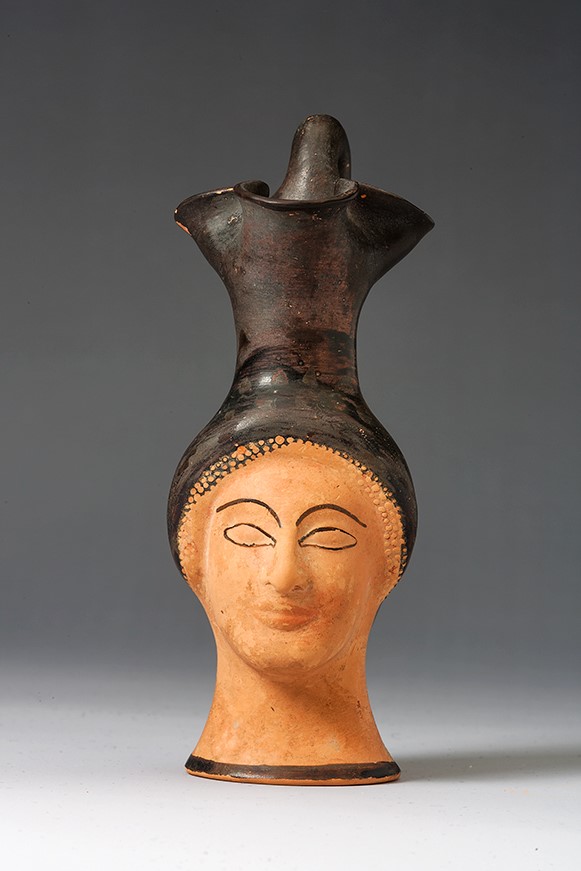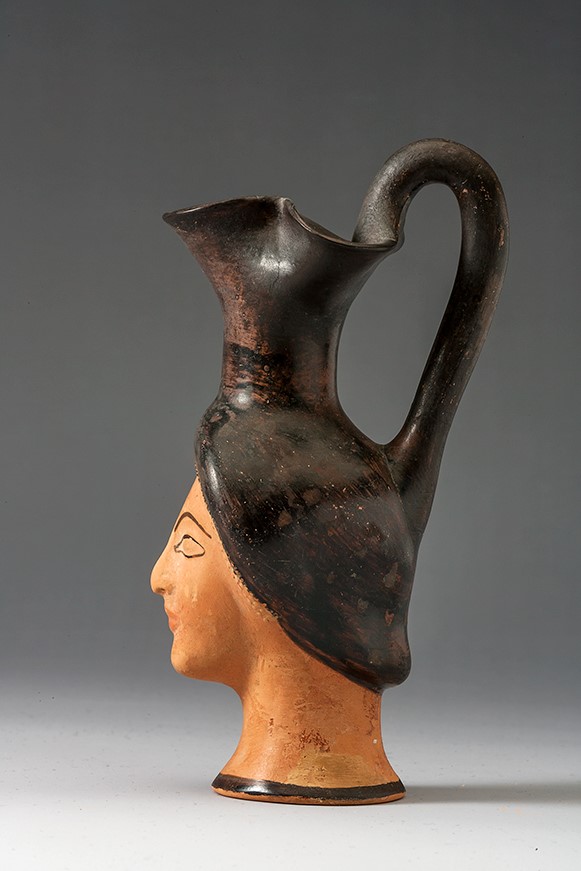Acquisition number: 1968.21
Attic Head Vase. Small oinochoe in the form of a woman's head. The hair and the neck, mouth and handle of the vase are painted black; there are touches of red in the front of the hair, on the lips and in the nostrils. Just visible are the remains of a white ivy-wreath around the hair. The handle is of circular section. There is a line of black at the base. The underside, which is flat, is reserved.
Title: Attic Head Vase - 1968.21
Acquisition number: 1968.21
Author or editor: J.R. Green
Culture or period: Greek Classical.
Date: c. 480 BC.
Material: Clay - Terracotta
Object type: Vase
Dimensions: 145mm (h)
Origin region or location: Greece
Origin city: Athens.
Display case or on loan: 3
Keywords: Greek, Classical, Attic, Moulded vase, Plastic vase
Sotheby (London), Sale Cat., 18 June 1968, no. 113 (ill.); J.R. Green with B. Rawson, Catalogue of Antiquities in the Australian National University, A.N.U. (Canberra, 1981) 36. Beazley, J.D., Paralipomena (Oxford, 1971): 503.20ter; T.H. Carpenter, with T. Mannack and M. Mendonca, Beazley Addenda, 2nd edition (Oxford 1989): 387; Beazley Archive Pottery Database 340177.
1968.21
Attic Head Vase
Purchased. Ht (lip) 14.5cm.
Intact but for part of the lip of the vase which has been restored. Small oinochoe in the form of a woman's head. The hair and the neck, mouth and handle of the vase are painted black; there are touches of red in the front of the hair, on the lips and in the nostrils. Just visible are the remains of a white ivy-wreath around the hair. The handle is of circular section. There is a line of black at the base. The underside, which is flat, is reserved.
Plastic (i.e. moulded) vases of this kind were not made at Athens until about 530 BC, although East Greek and Proto-Corinthian potters had made them much earlier. However, they continue to be made, though not very commonly, until the end of the fifth century.
The largest group, to which ours belongs, is called the Cook Class which can be dated to the first and second quarters of the fifth century. The long almond-shaped eyes and the stylised dots of the front hair recall late archaic statues, but the mouth has lost its archaic smile. An unusual feature is the absence of any indication of the iris or pupil of the eye which is clearly shown in other examples. Perhaps about 480 BC.
The Cook Class is named after a vase now in Dunedin, New Zealand that was formerly in the collection of A.B. Cook in Cambridge (Otago Museum E 48.236; A.B. Cook, Zeus ii [Cambridge 1925] pl. 21). There is also a head-vase like ours in the Classics Department Collection at the Victoria University of Wellington (1998.1,Charles Ede Ltd., London, Pottery from Athens (1995) no. 29 (colour ill.).
For lists and discussion of similar pieces, see J.D Beazley, Journal of Hellenic Studies 49, 1929, 61-65, Attic Red-Figure Vase-Painters (2nd ed., Oxford 1963) 1539-1544, Paralipomena 503-504, J.V. Noble, The Techniquesof Painted Attic Pottery (London 1965) 28-30. See also the useful series published by F. Croissant, “Collection Paul Canellopoulos IV: Vases plastiques attiques en forme de têtes humaines”, Bulletin de Correspondance Hellénique 97, 1973, 205-225; W.R. Biers, “Some Thoughts on the Origins of the Attic Head Vase”, in: W.G. Moon (ed.), Ancient Greek Art and Iconography (Madison 1983) 19-126, and see also B. Cohen (ed.), The Colors of Clay: Special Techniques in Athenian Vases (Los Angeles 2006), which illustrates a selection of head-vases at 268ff nos 79-81. There is an introduction to the subject by S. Ebbinghaus, “Of Rams, Women, and Orientals: A Brief History of Attic Plastic Vases”, in: Kenneth Lapatin (ed.), Papers on Special Techniques in Athenian Vases: Proceedings of a Symposium held … at the Getty Villa, June 15-17, 2006 (Los Angeles 2008) 145-160. E. Trinkl, D. Rieke-Zapp and L. Homer, “Face to face – Considering the Moulding of Attic Head Vases reconsidering Beazley’s Groups by Quantitative Analysis”, Journal of Archaeological Science: Reports 21, 2018, 1019-1024, have announced a programme of attempting to use other methods to classify them.
This piece is almost certainly Paralipomena 503, 20 ter, where Beazley compared the aryballos Amsterdam 3570, Corpus Vasorum Antiquorum Scheurleer (2) III K pl. 1, 2-3 (Pays Bas pl. 84).
Sotheby (London), Sale Cat., 18 June 1968, no. 113 (ill.); J.R. Green with B. Rawson, Catalogue of Antiquities in the Australian National University, A.N.U. (Canberra, 1981) 36. Beazley, J.D., Paralipomena (Oxford, 1971): 503.20ter; T.H. Carpenter, with T. Mannack and M. Mendonca, Beazley Addenda, 2nd edition (Oxford 1989): 387; Beazley Archive Pottery Database 340177.

